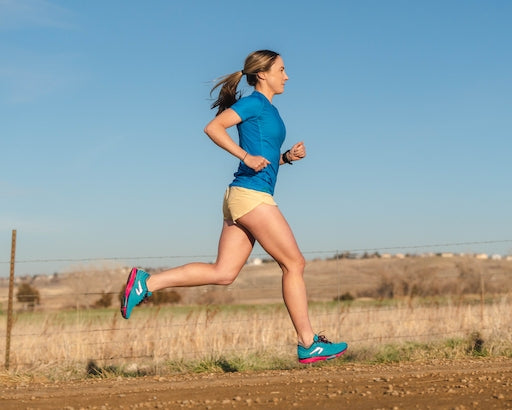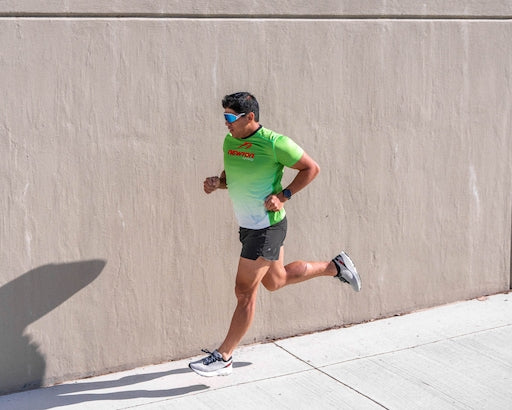
Breathe Like a Singer!
running science2 July 2012
 Christopher Holloway is a classically trained professional opera singer and musical theater performer from Tampa, Florida. In addition to performing, Christopher is also a private voice teacher with a Master’s Degree in Opera from Rice University. He has been running for three years, and he made the switch to Natural Running and Newton Running in February of 2012.
Christopher Holloway is a classically trained professional opera singer and musical theater performer from Tampa, Florida. In addition to performing, Christopher is also a private voice teacher with a Master’s Degree in Opera from Rice University. He has been running for three years, and he made the switch to Natural Running and Newton Running in February of 2012.
Not surprisingly, when I tell people that I am an opera singer, voice teacher, triathlete, and runner, they look at me like as if I am an alien… “Wow, I thought you’d be a little less, uh, FIT!..” hahah! Singing is definitely an athletic activity, and I really believe that my knowledge of proper breathing techniques helps my running tremendously.
In the past six months of running in Newton Running shoes, the Natural Running technique has been a process that I have really enjoyed studying and implementing. I am one of those success stories that are coming out about amateur runners moving to a zero or minimal drop shoe after experiencing extreme muscle and soft tissue pain in shoes with much greater drop from heel to forefoot (14mm drop in my shoes during training for my first marathon last November..it was AGONY!). As I continue to get stronger, more efficient, and faster (and running without soreness or pain), I am finding that proper breath is just as crucial as the forward lean, landing on the lugs or flat footed, letting the heel settle, and lifting the legs from the core all at 180 strides per minute. You can have the most efficient and perfect footstrike in the world, but if your shoulders are up around your ears or if you are flexing your abdominals around your ribcage during inhalation or exhalation, you are going to be susceptible to a whole host of issues while running, especially with any speed or distance.
How does breathing in an efficient and relaxed way assist us in training and in racing? The freer and more relaxed the breath is, the more efficiently you are going to be able to oxygenate the blood, and you will be able to take in more breath without wasting energy while running.
Many will say, “But, Natural Running calls me to engage my core…like this (flexes abdomen revealing a stunning six pack of abs).” Well, guess what? Yes, we must engage the core, but we have to know WHICH muscles support the body and those which help us move more air in and out effectively. The core of your body according to yoga and eastern religion is a few inches below your navel and 2-3 inches inward. This means that we are to engage the lower abdominal muscles to hold ourselves upright not by flexing the abs! It is definitely possible to engage the lower abs or core while relaxing the rest. It is the same with classical singing and being able to make sounds without the need for amplification. The power comes from engaging the LOWER abdominals and compressing the air on exhalation. Just as in regular life, when you speak, you don’t need to take much breath to make sound—when singing opera, the singer must inhale and exhale more air than “normal” humans take in. Along the same lines, when we run we must take in and exhale much more air than when we walk. There is a lot of power in the breath.
So let’s break down what happens when we breathe. Just for reference sake, the diaphragm is a dome shaped muscle that at rest is below the ribcage and the lungs. On proper inhalation, the lungs fill completely as a result of relaxed abdominal muscles (including the diaphragm). In classical and in proper technical singing, this movement of air is punctuated by an engaging or expanding of the lower abdominal muscles to keep the abdomen and ribcage from collapsing during exhalation. The only difference between classical singing breath and proper breath during running is the AMOUNT of engagement and lean out of the lower abs and the velocity of air that is exhaled (the air during singing is much more compressed, and the muscles of the abdomen don’t move as quickly back to their original position with empty lungs. While running, airflow should be constant, and the diaphragm should be constantly moving).
Okay, so now we know what happens when we breathe properly. Let’s explore some exercises.
One of the best ways to try this type of relaxed/easy breathing is by lying on your back and just breathing deeply through relaxed throat muscles as if you are yawning. If you focus on relaxing the abdominals during the breath, you will see the diaphragm and the abdomen rise and fall, and your shoulders will not rise up and become tense. Try to fill your lungs completely. Exhale completely. Notice the movement of the abdominals. I would also suggest that you try to inhale and exhale through BOTH your mouth and nose.
Inhale over 4 counts of approximately a cadence of 180 beats per minute, hold for 4 counts, then exhale over 4 counts. Really move that air with the diaphragm, especially on the exhalation.
To incorporate into your Natural Running form: Breathe in through your nose and mouth. Expand the abdomen during the inhalation and do not flex. Your lungs have reached capacity. Now exhale, and at the same time try to pull the diaphragm and move the expanded musculature up and inward until the next breath is necessary (air often just falls in at the end of an exhalation as long as your abdominals are relaxed!!). With the lower abdomen below the navel engaged or expanded but with the rest of the abs released you are going to feel extremely fat while implementing this technique. This is inevitable and OKAY! Vanity must go out the window! You may not look as killer in that new racerback halter top or shirtless (for the guys out there) but you sure are going to be using the air more efficiently. Forget about how you look; focus on how you breathe. The low engagement of the “core” keeps the pelvis level from front to back, which is hugely important, but flexing the abs does nothing but waste valuable energy.
Running cadence should be 180 strides a minute (again, if you are running in the 5:00’s or 12:00’s it’s the same), so, 4 strides breathe in, 4 strides breathe out is ideal for the breath. If you can inhale more that is wonderful–just make sure that the inhalation is the same duration as the exhalation (same is true for speedwork/racing—you may only get 2 strides in and two out).
As is true of natural running technique, it will take some coordination and adjustment to master this kind of breath because along the same lines as heel striking goes against how we were born to run, tight abdominals and constricted breath have become the norm how we breathe because we mostly use our abs to hold ourselves upright.
Add this focus on the breath to your Natural Running practice and implementation on the road or trail, and you will notice a significant change. I sing better because of my running, and you can bet that I run better because of my singing!!!! #HelloBetter!

